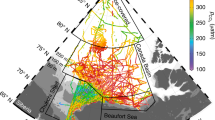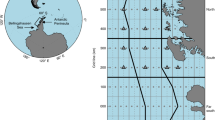Abstract
The biological pump is a central process in the ocean carbon cycle, and is a key factor controlling atmospheric carbon dioxide (CO2). However, whether the Arctic biological pump is enhanced or reduced by the recent loss of sea ice is still unclear. We examined if the effect was dependent on ocean circulation. Melting of sea ice can both enhance and reduce the biological pump in the Arctic Ocean, depending on ocean circulation. The biological pump is reduced within the Beaufort Gyre in the Canada Basin because freshwater accumulation within the gyre limits nutrient supply from deep layers and shelves hence inhibits the growth of large-bodied phytoplankton. Conversely, the biological pump is enhanced outside the Beaufort Gyre in the western Arctic Ocean because of nutrient supply from shelves and greater light penetration, enhancing photosynthesis, caused by the sea ice loss. The biological pump could also be enhanced by sea ice loss in the Eurasian Basin, where uplifted isohaline surfaces associated with the Transpolar Drift supply nutrients upwards from deep layers. New data on nitrate uptake rates are consistent with the pattern of enhancement and reduction of the Arctic biological pump. Our estimates indicate that the enhanced biological pump can be as large as that in other oceans when the sea ice disappears. Contrary to a recent conclusion based on data from the Canada Basin alone, our study suggests that the biological CO2 drawdown is important for the Arctic Ocean carbon sink under ice-free conditions.









Similar content being viewed by others
References
Aoyama M, Hydes DJ (2010) How do we improve the comparability of nutrient measurements? In: Aoyama M, Dickson AG, Hydes DJ, Murata A, Oh JR, Roose P, Woodward EMS (eds). Comparability of nutrients in the world’s ocean. Mother Tank, Tsukuba, pp 1–10
Arctic Climatology Project (1998) Environmental Working Group Joint US-Russian Atlas of the Arctic Ocean: summer period. Timokhov L, Tanis F (eds) Environmental Research Institute of Michigan in association with the National Snow and Ice Data Center, Ann Arbor. CD-ROM
Bates NR, Mathis JT (2009) The Arctic Ocean marine carbon cycle: evaluation of air–sea CO2 exchanges, ocean acidification impacts and potential feedbacks. Biogeosciences 6:2433–2459
Boyd TJ, Steele M, Muench RD, Gunn JT (2002) Partial recovery of the Arctic Ocean halocline. Geophys Res Lett 29:1657. doi:10.1029/2001GL014047
Brzezinski MA (1985) The Si:C:N ratio of marine diatoms: interspecific variability and the effect of some environmental variables. J Phycol 21:347–357
Cai, W-J, Chen L, Chen B, Gao Z, Lee SH, Chen J, Pierrot D, Sullivan K, Wang Y, Hu X, Huang W.-J, Zhang Y, Xu S, Murata A, Grebmeier JM, Jones EP, Zhang H (2010) Decrease in the CO2 uptake capacity in an ice-free Arctic Ocean basin. Science. doi:10.1126/science.1189338
Colony R, Timokhov L (2001) Hydrochemical Atlas of the Arctic Ocean. International Arctic Research Center, University of Alaska, Fairbanks, USA and State Research Center—the Arctic and Antarctic Research Institute, St. Petersburg, Russia, CD-ROM
Comiso JC, Parkinson CL, Gersten R, Stock L (2008) Accelerated decline in the Arctic sea ice cover. Geophys Res Lett 35:L01703. doi:10.1029/2007GL031972
Dickson AG (1996) Determination of dissolved oxygen in sea water by Winkler titration, In: WOCE Operations Manual, vol 3, Section 3.1, Part 3.1.3 WHP operations and methods, WHP Office Report WHPO 91-1, WOCE Report No. 68/91, Nov. 1994, Revision 1, Woods Hole, Massachusetts, USA
Dunne JP, Armstrong RA, Gnanadesikan A, Sarmiento JL (2005) Empirical and mechanistic models for the particle export ratio. Global Biogeochem Cycles 19:GB4026. doi:10.1029/2004GB002390
Hydes DJ, Aoyama M, Aminot A, Bakker K, Becker S, Coverly S, Daniel A, Dickson AG, Grosso O, Kerouel R, van Ooijen J, Sato K, Tanhua T, Woodward EMS, Zhang JZ (2010) Determination of dissolved nutrients (N, P, Si) in seawater with high precision and inter-comparability using das-segmented continuous flow analysers. In: Hood EM, Sabine CL, Sloyan BM (eds) The GO-SHIP repeat hydrography manual: a collection of expert reports and guidelines, IOCCP report number 14, ICPO publication series number 134, UNESCO-IOC, Paris, France. http://www.go-ship.org/HydroMan.html
Johnson MA, Polyakov IV (2001) The Laptev Sea as a source for recent Arctic Ocean salinity changes. Geophys Res Lett 28:2017–2020
Jones EP, Anderson LG (1986) On the origin of the chemical properties of the Arctic Ocean halocline. J Geophys Res 91(10):759–10767
Jones EP, Swift JH, Anderson LG, Lipizer M, Civitarese G, Falkner KK, Kattner G, McLaughlin F (2003) Tracing Pacific water in the North Atlantic Ocean. J Geophys Res 108:3116. doi:10.1029/2001JC001141
Jones EP, Anderson LG, Jutterström S, Mintrop L, Swift JH (2008) Pacific freshwater, river water and sea ice meltwater across Arctic Ocean basins: results from the 2005 Beringia Expedition. J Geophys Res 113:C08012. doi:10.1029/2007JC004124
Kawano T (2010) Method for salinity (conductivity ratio) measurement. In: Hood EM, Sabine CL, Sloyan BM (eds) The GO-SHIP repeat hydrography manual: a collection of expert reports and guidelines, IOCCP report number 14, ICPO publication series number 134, UNESCO-IOC, Paris, France. http://www.go-ship.org/HydroMan.html
Kikuchi T (2009) R/V Mirai Cruise Report MR09–03. JAMSTEC, Yokosuka
Lalande C, Bélanger S, Fortier L (2009) Impact of a decreasing sea ice cover on the vertical export of particulate organic carbon in the northern Laptev Sea, Siberian Arctic Ocean. Geophys Res Lett 36:L21604. doi:10.1029/2009GL040570
Lee SH, Whitledge TE (2005) Primary and new production in the deep Canada Basin during summer 2002. Polar Biol 28:190–197
Li WKW, McLaughlin FA, Lovejoy C, Carmack EC (2009) Smallest algae thrive as the Arctic Ocean freshens. Science 326:539
Markus T, Stroeve JC, Miller J (2009) Recent changes in Arctic sea ice melt onset, freezeup, and melt season length. J Geophys Res 114:C12024. doi:10.1029/2009JC005436
McLaughlin FA, Carmack EC (2010) Deepening of the nutricline and chlorophyll maximum in the Canada Basin interior, 2003–2009. Geophys Res Lett 37:L24602. doi:10.1029/2010GL045459
McLaughlin FA, Proshutinsky A, Carmack EC, Shimada K, Corkum M, Forsland V, Guay C, Guéguen C, van Hardenberg B, Hopcroft R, Itoh M, Krishfield R, Miller L, Nelson J, Richardson W, Sieberg D, Smith J, Steel M, Tanaka N, White L, Zimmermann S (2010) Physical, chemical and zooplankton data from the Canada Basin, August 2003. Canadian data report of hydrography and ocean sciences 184, Fisheries and Oceans, Science Branch, Pacific Region, Institute of Ocean Sciences, Sidney, British Columbia, Canada
Michaels AF, Silver MW (1988) Primary production, sinking fluxes and the microbial food web. Deep Sea Res 35:473–490
National Ice Center (2006) National Ice Center Arctic Sea ice charts and climatologies in gridded format. In: Fetterer F, Fowler C (eds) National Snow and Ice Data Center, Boulder
Nishino S, Shimada K, Itoh M, Yamamoto-Kawai M, Chiba S (2008) East–west differences in water mass, nutrient, and chlorophyll a distributions in the sea-ice reduction region of the western Arctic Ocean. J Geophys Res 113:C00A01. doi:10.1029/2007JC004666
Nishino S, Shimada K, Itoh M, Chiba S (2009) Vertical double silicate maxima in the sea-ice reduction region of the western Arctic Ocean: implications for an enhanced biological pump due to sea-ice reduction. J Oceanogr 65:871–883. doi:10.1007/s10872-009-0072-2
Proshutinsky A, Krishfield R, Timmermans M.-L, Toole J, Carmack E, McLaughlin F, Williams WJ, Zimmermann S, Itoh M, Shimada K (2009) Beaufort Gyre freshwater reservoir: state and variability from observations. J Geophys Res 114:C00A10. doi:10.1029/2008JC005104
Redfield AC, Ketchum BH, Richards FA (1963) The influence of organisms on the composition of seawater. In: Hill MN (ed) The Sea, vol. 2. Wiley, New York, pp 26–77
Sato K, Aoyama M, Becker S (2010) Reference materials for nutrients in seawater as calibration standard solution to keep comparability for several cruises in the world ocean in 2000s. In: Aoyama M, Dickson AG, Hydes DJ, Murata A, Oh JR, Roose P, Woodward EMS (eds) Comparability of nutrients in the world’s ocean. Mother Tank, Tsukuba, pp 43–56
Schlitzer R (2006) Ocean Data View. http://odv.awi.de
Shimada K (2002) R/V Mirai Cruise Report MR02–K05 Leg1. JAMSTEC, Yokosuka 226 pp
Shimada K (2008) R/V Mirai Cruise Report MR08–04 (R/V Mirai International Polar Year 2008 cruise). JAMSTEC, Yokosuka 163 pp
Shimada K, Kamoshida T, Itoh M, Nishino S, Carmack E, McLaughlin F, Zimmermann S, Proshutinsky A (2006) Pacific Ocean inflow: influence on catastrophic reduction of sea ice cover in the Arctic Ocean. Geophys Res Lett 33:L08605. doi:10.1029/2005GL025624
Subba Rao DV, Platt T (1984) Primary production of Arctic waters. Polar Biol 3:191–210
Tremblay J-É, Gagnon J (2009) The effects of irradiance and nutrient supply on the productivity of Arctic waters: a perspective on climate change. In: Nihoul JCJ, Kostianoy AG (eds) Influence of climate change on the changing Arctic and sub-Arctic conditions. Springer, Dordrecht, pp 73–92
Welschmeyer NA (1994) Fluorometric analysis of chlorophyll a in the presence of chlorophyll b and pheopigments. Limnol Oceanogr 39:1985–1992
Wheeler PA (1997) Preface: the 1994 Arctic Ocean Section. Deep Sea Res II 44:1483–1485
Woodgate RA, Aagaard K, Swift JH, Smethie WM, Falkner KK (2002) Chukchi Borderland Cruise CBL2002 Arctic West: phase II (AWS-02-II). University of Washington, Seattle 51 pp
Yamamoto-Kawai M, McLaughlin F, Carmack E, Nishino S, Shimada K (2009) Aragonite undersaturation in the Arctic Ocean: effects of ocean acidification and sea ice melt. Science 326:1098–1100
Yang J (2009) Seasonal and interannual variability of downwelling in the Beaufort Sea. J Geophys Res 114:C00A14. doi:10.1029/2008JC005084
Acknowledgments
We thank K. Shimada, the chief scientist of the R/V Mirai cruises in 2002 and 2008, and the captain, officers, and crew of the R/V Mirai, which was operated by Global Ocean Development, Inc. We also thank the staff of Marine Works Japan, Ltd. for their skillful work aboard the ship and with data processing. Geographical maps and figures were illustrated using Ocean Data View software (Schlitzer 2006).
Author information
Authors and Affiliations
Corresponding author
Rights and permissions
About this article
Cite this article
Nishino, S., Kikuchi, T., Yamamoto-Kawai, M. et al. Enhancement/reduction of biological pump depends on ocean circulation in the sea-ice reduction regions of the Arctic Ocean. J Oceanogr 67, 305–314 (2011). https://doi.org/10.1007/s10872-011-0030-7
Received:
Revised:
Accepted:
Published:
Issue Date:
DOI: https://doi.org/10.1007/s10872-011-0030-7




